 by "ttyymmnn" (ttyymmnn)
by "ttyymmnn" (ttyymmnn)
Published 01/19/2017 at 12:35
 by "ttyymmnn" (ttyymmnn)
by "ttyymmnn" (ttyymmnn)
Published 01/19/2017 at 12:35
Tags: wingspan
; planelopnik
; planes you've probably never heard of
STARS: 5
From the Planes Youíve (Probably) Never Heard Of Department of Wingspan , we bring you the Cornelius XFG-1. There is an old adage that says necessity is the mother of invention, and there have been many cases where sudden need has provided some truly magnificent aircraft. The Cornelius XFG-1 was not one of them.
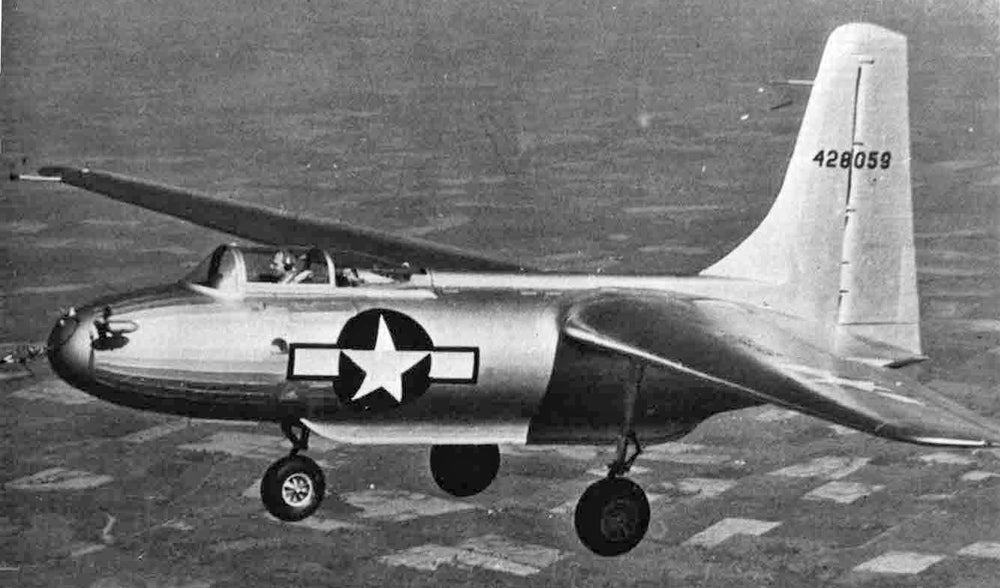
When the United States went to war against Japan following the attack on Pearl Harbor, they faced another enemy that was almost as difficult to overcome as the Japanese military: the vast distances of the Pacific Ocean. Before the campaign of island hopping moved American air bases closer to the Japanese homeland, bombers simply didnít have the fuel capacity necessary to reach Tokyo and return to base. The famous
Doolittle Raid
of 1942 saw
North American B-25 Mitchell
bombers take off from the deck of the
USS Hornet
, but then continue on to mainland China, where many of the bombers crashed and their crews were killed or captured. But, if you couldnít put enough fuel on board the plane, why not bring an extra fuel tank along for the ride? That was exactly the idea behind the Cornelius XFG-1.
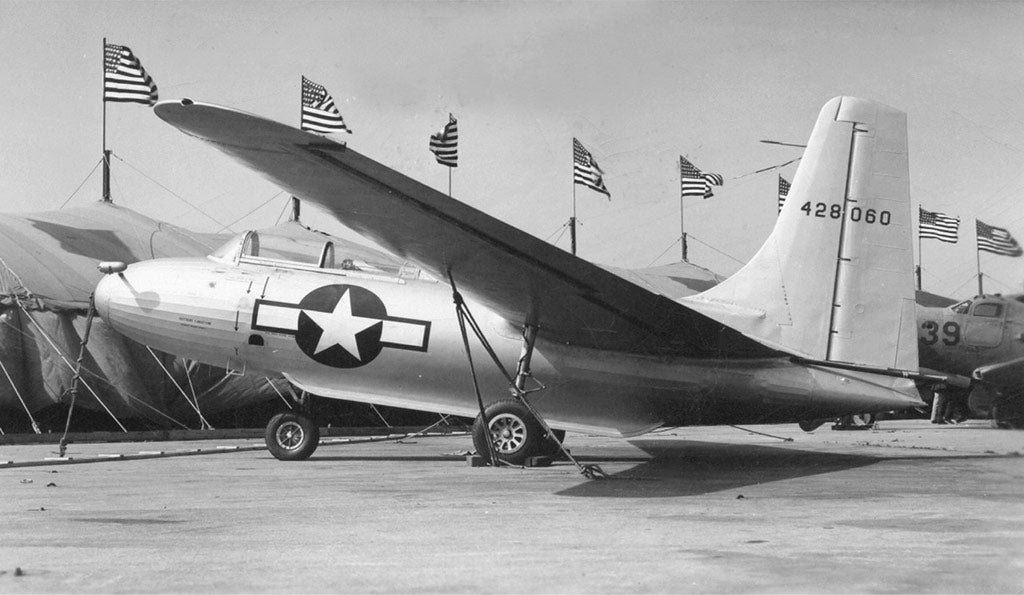
Since the 1920s, inventor George Cornelius had been experimenting with gliders of different design, and one of his early designs was the Cornelius Mallard , a radical aircraft that featured a forward swept wing, vertical stabilizer, but no horizontal stabilizer. The functions of the horizontal stabilizer, or elevator , were carried out by elevators placed close to the fuselage, while ailerons farther out on the wing performed their usual function. A forward-swept wing, in itself, is not a terrible idea. Since the air flow over the wing moves towards the fuselage rather than towards the wingtip, the design helps reduce the chances of a wingtip stall inherent in traditionally swept wings. However, as the aircraft yaws from side to side, the retreating wing loses its sweep and creates more drag, leading to greater instability. Cornelius claimed that the Mallard, which formed the basis of the XFG-1, was both stall-and spin-proof, though experience with the larger XFG-1 would prove otherwise.
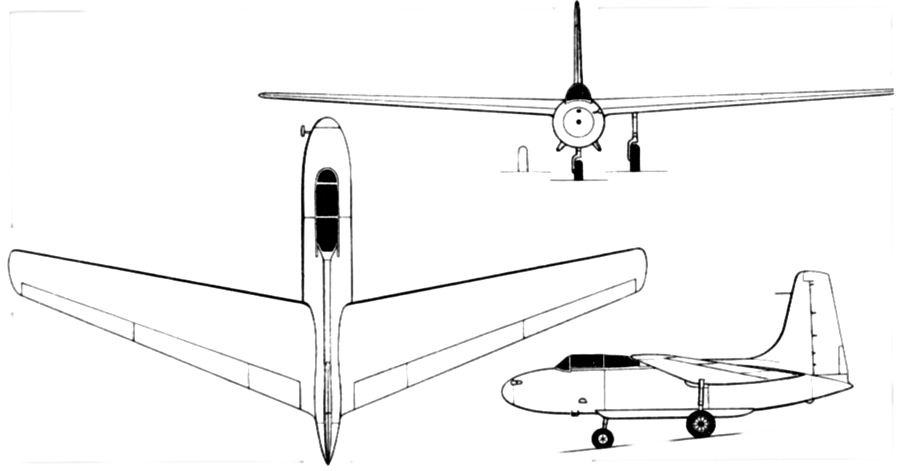
Not only was the XFG-1 a radical design, the entire concept was somewhat harebrained as well. The idea was that the unpowered XFG-1 would be filled with 764 gallons of aviation fuel and towed behind the bomber. Once all the fuel was transferred to the bomber, the glider would be released and allowed to crash on its own. The bombers would then have sufficient fuel to reach Japan and return to base. However, ditching the flying fuel tank was a rather wasteful proposition, so Cornelius developed a piloted version. Once released from the bomber, the glider would then be flown safely to the ground. However, it was never entirely clear exactly where the pilots were supposed to land their flying drop tank. Behind enemy lines? In the Pacific Ocean? Needless to say, there were probably very few pilots who would volunteer for such a mission.
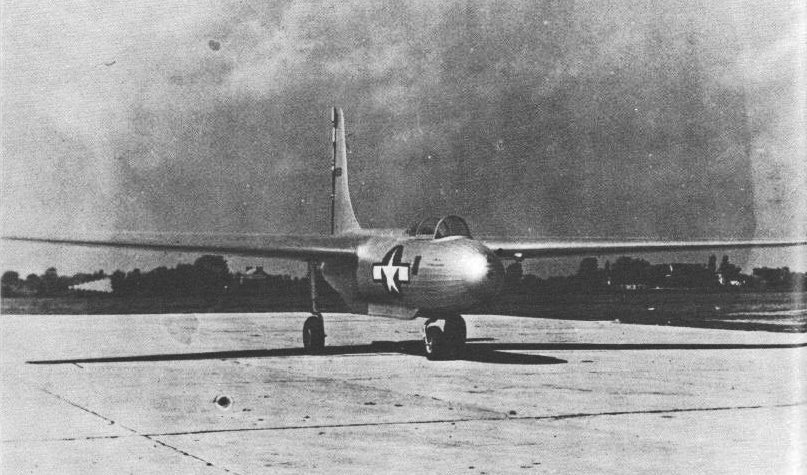
Cornelius built two prototypes of the XFG-1. The glider took its maiden flight in 1944, and the two prototypes completed 32 test flights. However, despite Corneliusí claim to the contrary, the XFG-1 was anything but spin-proof and, during one of the test flights, the first prototype entered an unrecoverable spin and crashed, killing the pilot. By the end of the testing program in 1945, the Allies had moved close enough to Japan that the XFG-1 was no longer needed, so the US Army Air Forces dropped the idea. Cornelius was undaunted, though, and continued to develop the concept, though he eventually gave up after the war when the USAAF began to develop dedicated refueling aircraft.
(Photo authors unknown)
!!! UNKNOWN CONTENT TYPE !!!
!!! UNKNOWN CONTENT TYPE !!!
!!! UNKNOWN CONTENT TYPE !!!
!!! UNKNOWN CONTENT TYPE !!!
!!! UNKNOWN CONTENT TYPE !!!
!!! UNKNOWN CONTENT TYPE !!!
!!! UNKNOWN CONTENT TYPE !!!
If you enjoy these posts, please join in the conversation and let me know. If you missed an episode, you can find them all at Wingspan .
!!! UNKNOWN CONTENT TYPE !!!
 "Chariotoflove" (chariotoflove)
"Chariotoflove" (chariotoflove)
01/19/2017 at 12:47, STARS: 0
The brass must have been really desperate to even have considered such a scheme.
 "ttyymmnn" (ttyymmnn)
"ttyymmnn" (ttyymmnn)
01/19/2017 at 12:49, STARS: 0
Desperate times, and wartime budgets. Itís difficult to say just how seriously the USAAF pursued this, but they went far enough to fund two prototypes and a bunch of testing.
One of the interesting things about this glider is that its design allowed it to be towed at the cruising speed of the bomber, where other gliders, such as troop-carrying gliders, had to be towed at slower speeds.
 "Chariotoflove" (chariotoflove)
"Chariotoflove" (chariotoflove)
01/19/2017 at 13:03, STARS: 1
Oh, I can appreciate the innovative aspects. They just seem misapplied. Also, though I am not an engineer, it would seem to me that hauling a loaded tanker plane with your bomber would decrease the range of said bomber, thus reducing the utility of the glider fur its stated purpose.
 "ttyymmnn" (ttyymmnn)
"ttyymmnn" (ttyymmnn)
01/19/2017 at 13:08, STARS: 0
Iím certainly no aerodynamicist, but there would certainly be added drag. How much? I have no idea. I didnít come across any discussions of that in my reading.
 "TheRealBicycleBuck" (therealbicyclebuck)
"TheRealBicycleBuck" (therealbicyclebuck)
01/19/2017 at 13:22, STARS: 0
The lift and drag profiles for the glider would have to be similar to the bomber, especially of the glider was to be unmanned. Too much difference and itís easy for things to spiral out of control.
Source: I am rated for hang-glider aerotow and Iíve had things get wonky enough to require an emergency tow release.
This isnít me, but the videos below show how it works. The best part in the first video is at 1:09 where he catches sight of the tow vehicle, a Dragonfly ultralight.
!!! UNKNOWN CONTENT TYPE !!!
This one shows the maneuvering required to get lined up behind the tow plane after take-off.
!!! UNKNOWN CONTENT TYPE !!!
 "Chariotoflove" (chariotoflove)
"Chariotoflove" (chariotoflove)
01/19/2017 at 13:23, STARS: 2
I wonder if you could drag it close enough to take advantage of the slipstream at all, or if that would just be too dangerous. My guess would be the latter, but I have no data.
 "ttyymmnn" (ttyymmnn)
"ttyymmnn" (ttyymmnn)
01/19/2017 at 13:32, STARS: 0
That looks like funófor somebody else. Iíd be scared shitless up there. Iíve never seen that aerotow set up before.
 "AfromanGTO" (afromangto)
"AfromanGTO" (afromangto)
01/19/2017 at 13:33, STARS: 0
That has bad idea written all over it. What would happen if those went into services and the enemies actually shot them. Hopefully they would have designed a quick way to disconnect them. Big slow planes that are towing gas tanks with wings behind them.
 "ttyymmnn" (ttyymmnn)
"ttyymmnn" (ttyymmnn)
01/19/2017 at 13:38, STARS: 0
My biggest WTF about this aircraft is that they actually thought they could find pilots to fly in them.
 "TheRealBicycleBuck" (therealbicyclebuck)
"TheRealBicycleBuck" (therealbicyclebuck)
01/19/2017 at 13:48, STARS: 1
Itís tons of fun. The standard is a flat rate for a tow to 1,500 ft., then an extra $5 for every 500 above that. If you donít release at 1,500, the tow pilot keeps going.
On my third or fourth tow, the tow pilot didnít know I wasnít equipped with a vario/altimeter. When I didnít release at 1,500, he kept going. When I didnít release at 2,000, he kept going. Of course, I was waiting for him to let up and wave me off. Never seeing the signal, I just held on for the ride.
At 2,500 ft., he realized that something was up and decided to see how long Iíd stick with it. I started getting nervous when we reached cloud base and passed between a couple of big clouds. That was about 5,000 ft. After we passed cloud base, he turned and the airport disappeared behind the cloud. Once the tow pilot realized what he had done, he circled back around so I could see the airport and waved me off. He later told me we were at 5,500 ft. AGL.
While experienced pilots would have been looking for lift, I was just trying to get back to solid ground. Once I landed, I was treated to a heroís welcome. They had such a good laugh about it that they didnít charge me for anything above the base rate. That was welcome news - I didnít have an extra $30 in my pocket!
 "ttyymmnn" (ttyymmnn)
"ttyymmnn" (ttyymmnn)
01/19/2017 at 13:57, STARS: 0
Hey! The mile high club! I would have been shitting my pants. Does the tow snag a line, or do you both start out on the ground?
 "TheRealBicycleBuck" (therealbicyclebuck)
"TheRealBicycleBuck" (therealbicyclebuck)
01/19/2017 at 14:08, STARS: 1
Well, not THAT mile-high club!
Both aircraft start on the ground. The glider rests in a wheeled dolly since the take-off speed is much faster than you can run. This shows the starting position for the hang-gliding pilot.
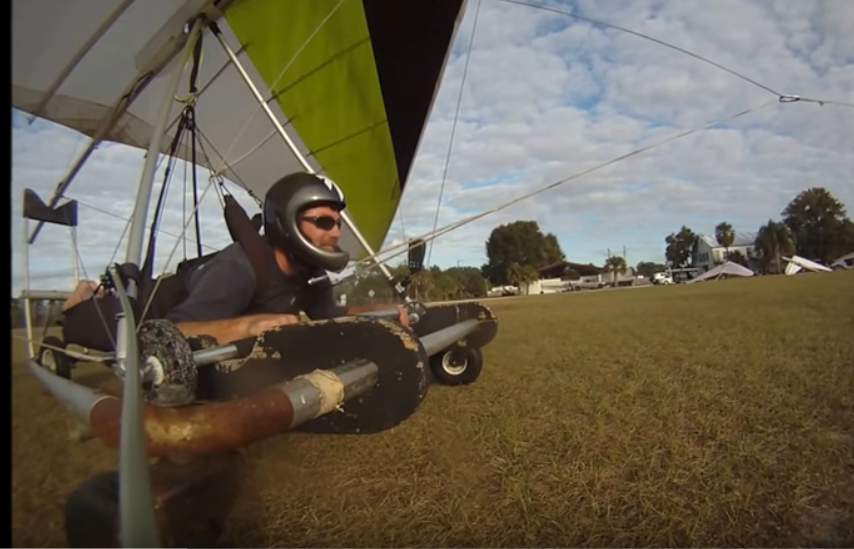
The pipe and wood cradle has caster wheels in front and a single wheel in back. The wheel by the pilotís hand is on the gliderís control frame and is there to prevent nose-overs if the pilot trips on landing. The tow line attaches to the keel and the pilot so the towing force is distributed between both and the pilot can maintain control. Lift-off for the glider is before the tow plane gets off the ground and usually happens within 20-30 feet.
This is what it looks like from behind. The yellow ďwingsĒ on the pilotís helmet are the wings of the tow plane, an ultralight called the Dragonfly.
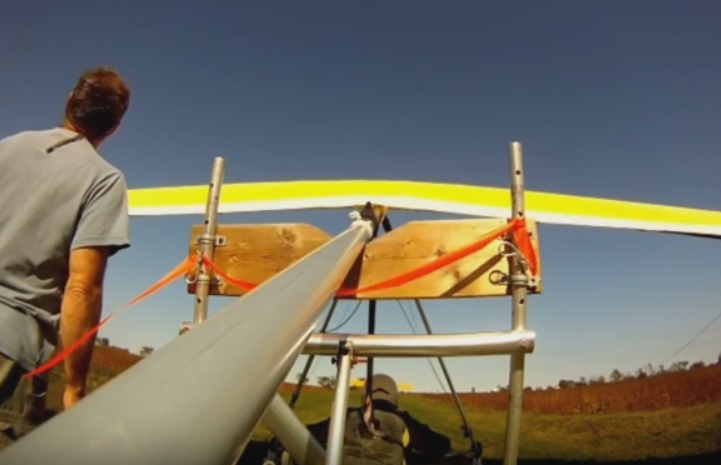
 "e36Jeff now drives a ZHP" (e36jeff)
"e36Jeff now drives a ZHP" (e36jeff)
01/19/2017 at 16:14, STARS: 0
Well, it needs to use more fuel to cover a given distance while it was towing the fuel tank/glider thing. But once it uses up all the fuel in the glider, you now have a fully fueled bomber in the air that is several hundred miles closer to its target, so overall itís range will go up.
 "AfromanGTO" (afromangto)
"AfromanGTO" (afromangto)
01/20/2017 at 17:45, STARS: 1
You can always find pilots to fly anything. They are up to the challenge. I think they probably should have used radio control with these to land, and have a bomb in them to blow up when done.
 "ttyymmnn" (ttyymmnn)
"ttyymmnn" (ttyymmnn)
01/20/2017 at 18:00, STARS: 1
You can always find pilots to fly anything.
As evidenced by the courageous test pilots in the 50s. Iíve got to believe that more than a few of them thought, if not said, ďYou want me to fly that ?Ē
 "AfromanGTO" (afromangto)
"AfromanGTO" (afromangto)
01/20/2017 at 18:52, STARS: 2
They were probably bribed with some smokes and good strong liquids when they got back on the ground.